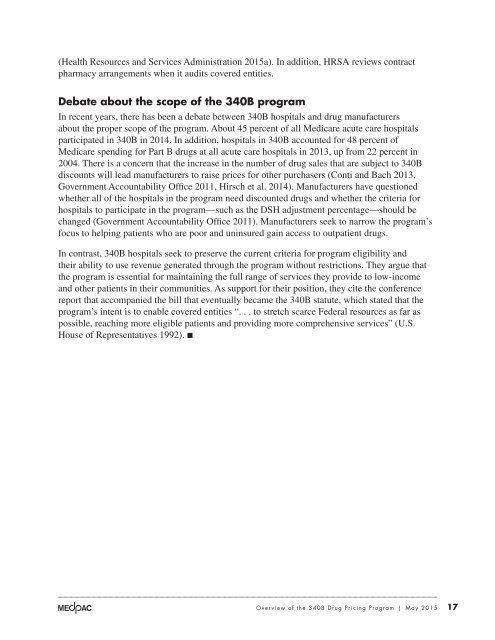Overview of the 340B Drug Pricing Program
1Mmfbin
1Mmfbin
Create successful ePaper yourself
Turn your PDF publications into a flip-book with our unique Google optimized e-Paper software.
(Health Resources and Services Administration 2015a). In addition, HRSA reviews contract<br />
pharmacy arrangements when it audits covered entities.<br />
Debate about <strong>the</strong> scope <strong>of</strong> <strong>the</strong> <strong>340B</strong> program<br />
In recent years, <strong>the</strong>re has been a debate between <strong>340B</strong> hospitals and drug manufacturers<br />
about <strong>the</strong> proper scope <strong>of</strong> <strong>the</strong> program. About 45 percent <strong>of</strong> all Medicare acute care hospitals<br />
participated in <strong>340B</strong> in 2014. In addition, hospitals in <strong>340B</strong> accounted for 48 percent <strong>of</strong><br />
Medicare spending for Part B drugs at all acute care hospitals in 2013, up from 22 percent in<br />
2004. There is a concern that <strong>the</strong> increase in <strong>the</strong> number <strong>of</strong> drug sales that are subject to <strong>340B</strong><br />
discounts will lead manufacturers to raise prices for o<strong>the</strong>r purchasers (Conti and Bach 2013,<br />
Government Accountability Office 2011, Hirsch et al. 2014). Manufacturers have questioned<br />
whe<strong>the</strong>r all <strong>of</strong> <strong>the</strong> hospitals in <strong>the</strong> program need discounted drugs and whe<strong>the</strong>r <strong>the</strong> criteria for<br />
hospitals to participate in <strong>the</strong> program—such as <strong>the</strong> DSH adjustment percentage—should be<br />
changed (Government Accountability Office 2011). Manufacturers seek to narrow <strong>the</strong> program’s<br />
focus to helping patients who are poor and uninsured gain access to outpatient drugs.<br />
In contrast, <strong>340B</strong> hospitals seek to preserve <strong>the</strong> current criteria for program eligibility and<br />
<strong>the</strong>ir ability to use revenue generated through <strong>the</strong> program without restrictions. They argue that<br />
<strong>the</strong> program is essential for maintaining <strong>the</strong> full range <strong>of</strong> services <strong>the</strong>y provide to low-income<br />
and o<strong>the</strong>r patients in <strong>the</strong>ir communities. As support for <strong>the</strong>ir position, <strong>the</strong>y cite <strong>the</strong> conference<br />
report that accompanied <strong>the</strong> bill that eventually became <strong>the</strong> <strong>340B</strong> statute, which stated that <strong>the</strong><br />
program’s intent is to enable covered entities “. . . to stretch scarce Federal resources as far as<br />
possible, reaching more eligible patients and providing more comprehensive services” (U.S.<br />
House <strong>of</strong> Representatives 1992). ■<br />
<strong>Overview</strong> <strong>of</strong> <strong>the</strong> <strong>340B</strong> <strong>Drug</strong> <strong>Pricing</strong> <strong>Program</strong> | May 2015 17


